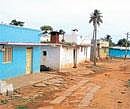
A day after the men who were suspected to be dacoits and done to death by a lynch mob in the Barlahalli and Yerrakote villages of Tumkur taluk, the police arrested 73 people. One of the attack victims, Gangadhar continues to be under treatment at Nimhans in Bangalore. His condition is stated to be serious.
According to Superintendent of Police T D Pawar, there is little evidence to suggest whether the 11 young men came to the two villages to commit dacoity.
“It is also not known for certain whether they were the ones who attacked a woman near Muddulapalli. But preliminary investigation indicates that the 11 men were sellers of imitation gold ornaments. Many cases of selling fake jewellery were registered in the past against them in some police stations of the taluk,” Pawar said.
The image of a mob chasing the men and then lynching them lingers in the minds of the residents of Barlahalli and Yerrakote.
The killings appear to be a manifestation of people’s frustration against police inaction in checking increasing instances of theft and dacoity in the villages.
The rising number of crimes allegedly involving outsiders had made the residents of Barlahalli and Yerrakote xenophobic. They are furious that any miscreant handed over to the police would be released within no time.
“We were disgusted with the spate of thefts and the police inaction. There was no alternative to killing the perpetrators of the crimes,” said a resident who did not want to be named.
“Strangers would drive up on motorbikes, day and night, and harass women. Some women were sexually assaulted. The marauders would barge into farmhouses, threaten the residents with lethal weapons, before vanishing with household articles,” said another villager.
Poor and unemployed people live in the sparsely populated villages bordering Andhra Pradesh, and some of them have taken to crime. Dacoits from the neighbouring state operate in cahoots with their local accomplices, rob people in broad daylight and molest women.
The villagers complained that despite filing cases of dacoity and robbery, the police took no action.
The stories and strife that gripped the villages transformed into rage on Tuesday, exploding into deadly violence at Barlahalli and Yerrakote.
Of all the taluks in Kolar and Chikkaballapur districts, Chintamani has the dubious record of having the highest number of cases of mob violence and vandalism leading to death. Nearly three decades ago, some people assaulted a block development officer who had come to demolish an illegally constructed building. His jeep was set on fire, but no police action followed.
The locals have continued to disobey the law since then. In 1998, three policemen were lynched at Billandlahalli when they were trying to check violence between two caste groups during Ambedkar Jayanti celebration.
In 2000, members of a community set houses of dalits on fire and burnt alive nine inhabitants—an action that was triggered by the murder of waterman Krishnareddy who belonged to the upper caste.
About five years ago, a deputy superintendent of police was thrashed by the public during elections to the taluk and zilla panchayats. None of the offenders in these incidents of mob violence was punished due to lack of evidence and witnesses.
“Such a history has emboldened the local people that they could take the law into their hands. And in some rarer cases when police action followed, the culprits spent only a few days in jail before they were released on bail,” a lawyer said.
Defending his force, Pawar said the villagers have been consistently reminded that they hand over thieves or dacoits to the police.
